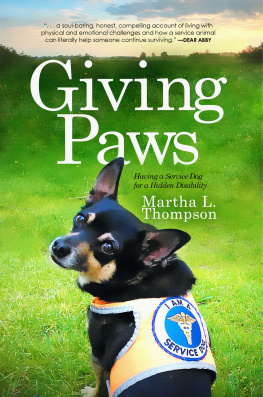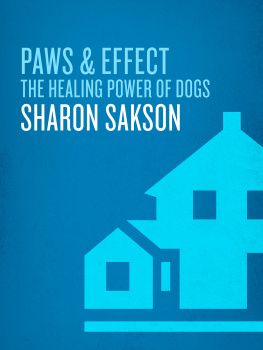Praise for
Giving Paws
Martha L. Thompsons book, Giving Paws: Having a Service Dog for a Hidden Disability is a soul-baring, honest, compelling account of living with physical and emotional challenges and how a service animal can literally help someone continue surviving.
DEAR ABBY
Giving Paws is a gem of a book, as entertaining as it is educational. Readers will fall in love with Henry, a little dog with a big heartand an important job to do.
BRENDA SCOTT ROYCE, author of Monkey Love, Champions New Shoes and Bailey the Wonder Dog
Everyone knows someone with an invisible illness or disability. Yet too few truly appreciate the difficulties faced by those who suffernot only from the illness, but from the lack of understanding from those closest to them. Giving Paws: Having a Service Dog for a Hidden Disability is a heartfelt and moving story of one womans journey living with invisible illness and disability. It is a must-read for anyone who wants to better understand the challenges that face a family member, loved one or friend with an invisible disability.
WAYNE CONNELL, Founder and President, Invisible Disabilities Association
Martha writes with candor, compassion and love for her animals, especially her Service Dog, Henry. She teaches us the many ways Service Dogs can enrich and enable the lives of people who need them. I learned a LOT!
This book is for anyone who loves dogs, wants or needs a Service Dog or wants to understand how vital they are to someone with a disability. I thoroughly enjoyed it.
PAM WRIGHT25 year Docent for the Greater Los Angeles Zoo Association
This memoir is a testament to strength of the bond between dogs and humans, and to the resiliency of our relationships with them. Service dogs, no matter what their size or breed, provide beacons of hope, comfort and vital assistance to those who rely on them. As is told in this moving story, little Henry turned out to be the ideal co-pilot for his person, Martha.
CLAUDIA KAWCZYNSKAThe Bark | Editor-in-Chief
When I read Martha Thompsons first draft of Giving Paws more than three years ago, I knew this work had the potential to become a published memoir. Thompson became a professional writer during the process, learning the difficult task of editing and rewriting her own work. The final product is compelling, harrowing and heartwarming. It is a confession, an entertainment and gentle advocacy for those who can benefit from having service animals in their lives, for differing health reasons. Based on other work Ive seen from Thompson, I know she has many more stories to tell. Keep your eye on this writer.
STEVEN STIEFEL, writer and memoir editor, Co-writer of Making Rumours, with Ken Caillat, the albums producer.

Giving Paws:
Having a Service Dog for a Hidden Disability
by Martha L. Thompson
Copyright 2017 Martha L. Thompson
ISBN 978-1-63393-499-3
All rights reserved. No part of this publication may be reproduced, stored in a retrieval system, or transmitted in any form or by any meanselectronic, mechanical, photocopy, recording, or any otherexcept for brief quotations in printed reviews, without the prior written permission of the author.
Published by

210 60th Street
Virginia Beach, VA 23451
800-435-4811
www.koehlerbooks.com
For my husband Don
Introduction
WHEN I REACHED MY FORTIES, I was pretty healthy, which was surprising because Id been battling the demons of anorexia nervosa since adolescence, and a primary immunodeficiency disease since my mid-thirties. This disease, Common Variable Immune Deficiency, or CVID, was anything but common. It caused me to have collagenous colitis, a fancy name for daily diarrhea, and coccidioidomycosis, or valley fever, which destroyed my left lung. The lung was removed and I started getting monthly infusions of immunoglobulin. Supposedly, this would keep me from getting any more life-threatening infections.
In the ten years that followed my CVID diagnosis, I had fewer horrible infections, but continued my mad dashes to the bathroom, which triggered dizzy spells and frequent fainting. My internist referred me to a cardiologist who ran a lot of tests and found that I had low blood pressure and a thickened heart valve. He wasnt terribly worried, and suspected my fainting was due to dehydration and malnutrition. I thought hed send me back to the gastroenterologist, but he had something else in mind. He suggested I get a service dog.
Id heard that dogs could be trained to assist people with both physical and psychiatric illnesses, but the idea of getting one hadnt occurred to me. Were my illnesses serious enough to warrant a service dog? According to my doctor and the Americans with Disabilities Act, they were. With the hope of restoring some normality to my life, I took my doctors advice.
I adopted an irresistible, black and tan dachshund/chihuahua puppy and named him Henry. For nine months, we went to class and practiced diligently. He learned specific tasks to assist me, and I learned how to communicate with him. As a team, we were tested by a certified service dog trainer and Henry started coming with me to work. Navely, I believed his support would magically restore my health and make life easier. I was wrong.
During the first week of having Henry with me in my office at the zoo, his presence drew so much attention to me and my disability, I wanted to crawl under my desk and hide. Complete strangers asked, Whats wrong with you? I got so embarrassed about being ill, I wanted to abandon the whole idea and just let Henry be a pet.
When a person with a service dog has an obvious disability like blindness, no one asks questions or passes judgment, but when people looked at me they saw a skinny person with a little dog, and wondered what my problem was. They wanted to know why I needed him. Telling complete strangers about my compromised immune system and anorexia was humiliating. Even after I answered their questions, many still didnt understand. Henrys Tom Thumb stature and disarming dog appeal fueled their curiosity, causing them to stare and ask, Hes so little. How does he help you? At the time, I wished I had chosen a big ugly dog so onlookers would have left us alone.
I loved little Henry, but his presence was making my life harder, not better. I wanted to give up and let him retire, but fortunately, Henry wasnt ready for that. He did his job and stuck with me as I learned to negotiate life with a service dog.
CHAPTER 1
Gus
DOGS INSTINCTIVELY RESPOND WHEN their owners show signs of distress. They want to be near you when youre sick in bed, and can lift your spirits if youre feeling blue. My experience with the healing ability of dogs started with a special German shepherd mix named Gus, who was not a trained service dog, but intuitively supported me when I needed him.
Gus came into my life when I was a thirty-one-year-old actor living in a one-bedroom apartment on Central Park West Avenue and 103rd street in Manhattan in 1991. This put me just a few blocks south of Harlem, across from the unpopulated, junkie-ridden northern part of the famous park, and half a block east of a huge, crime-infested cluster of housing projects. My apartment was on the second floor of a four-story building that faced 103rd street, directly above a subway station. This meant I could feel and hear people coming and going into the hole in the ground at all hours of the day and night. The pulse of the neighborhood was unsettling.














